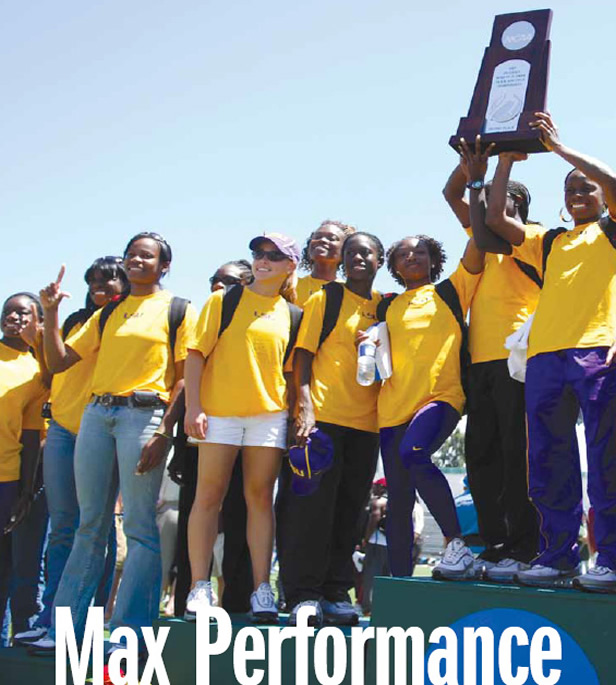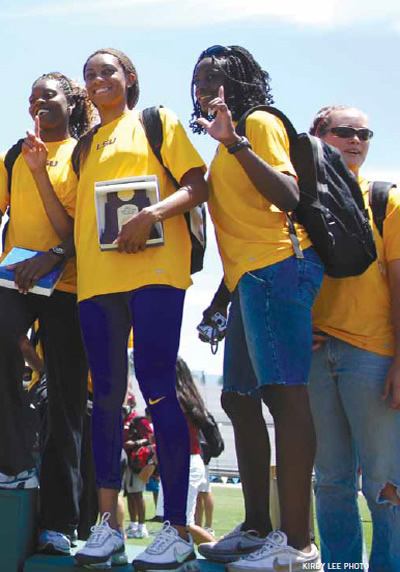| Max Performance: Tips for getting organized and getting things done |
| By: Andrea Tepe
Originally Published in Techniques Magazine Provided by: USTFCCCA
The beauty of our sport is the diversity: cross country, sprints, throws, jumps, relays, multi-events. The same things that make our sport interesting and valuable can also make it a challenge. When one competition season ends, the next one is beginning and if it isn't the middle of a competitive season, it means coaches are hitting the road recruiting and making arrangements for the upcoming year. We all face the same time restraints and it can be a challenge to find time to fulfill our responsibilities during regular business hours. When days in the office are limited because of travel, it is important to make the most of the time we do have at our desks by working efficiently. DAY TO DAY EFFICIENCY Working in an office typically means a lot of interruptions. There are times when interruptions can completely disrupt a task you are working on, possibly wasone is out to lunch or the other coaches are out at practice, and complete those tasks during that designated time. You could also consider adjusting your office hours slightly if you need quiet time without distraction. When making an effort to become more efficient, instead of thinking, "we've always used information A and done B to get to C" try thinking, "with information A, what is the best way to get to C?" It is possible that B wasn't the most efficient way, even if it was equally effective. MEETINGS Regular meetings with all staff members present are crucial to having an organized program where everyone is on the same page. Keeping meetings productive and on task is the responsibility of whoever is running the meeting, most likely the head coach, but can be aided by having a meeting agenda. This can help you accomplish all of the goals that you have for the brief amount of time that everyone is in the same room together. Agendas allow everyone to have a paper to take notes on as well as something to take away from the meeting for a reminder of what was discussed. Meet Management Sometimes it feels impossible to be efficient during a home meet, especially for the meet director. If your institution doesn't host many competitions, it may just be a day or two during the year that you struggle through and breathe a sigh of relief when it's over. If you host a lot of competitions, it is easier to experiment with ways to be efficient in your preparation during the months and the days leading up to the meet. Meet information is the first order of business for any host institution. It is helpful to post meet information as early as possible but whatever is posted should be as close to final as possible. When writing your meet information, all the necessary information coaches need to know for your competition should be addressed. Changing deadlines, meet policies or drastically modifying a schedule after meet information has been posted should be avoided. Remember to always include a date and time stamp as to when the document was last revised. The days leading up to hosting a meet involve finalizing details. There are some modifications to meet information that are inevitable and sometimes cannot be made until entries close, such as a time schedule. If you modify your time schedule, make sure to indicate that it is a final schedule versus a tentative schedule that should have been originally published. Any changes to the general meet information should be highlighted so coaches can easily note the changes. Don't forget to update your time stamp! When you host a competition, you should always save any documents that you create. This will help in the future as a method of refreshing your memory of the policies that were in place, the information that was provided to visiting schools, and it will save you time in the future. Keep general documents that are used for all home meets in a separate folder so they can be easily found and updated. This also serves as a sort of checklist to make sure crucial details are not left out. If you are planning on utilizing the same meet management policies, relay cards, or other general documents for each meet you host, you can prepare these items ahead of time. Throughout the duration of the meet and immediately following, you should take notes to serve as reminders for the next time you are preparing for a similar event. You should include what went well, what did not work, any ideas that were tossed around during the event that are worth revisiting, and any changes that should be made to the meet itself as well as the time schedule. COMPLIANCE/BUSINESS PAPERWORK Every department has different policies and forms for their compliance and business offices. Make sure you understand how your department works and which forms need to be completed prior to each task you perform. For example, at our institution, for a single individual to come on an official visit, there are eight different forms that need to be completed for our compliance office to approve all aspects of the visit. Completing these forms is clearly a task that takes time but it is important to find a way to complete them efficiently while also remembering to complete each one. I will share what works for me in my department, although that doesn't mean it will necessarily be the best way for you as an individual or for your department's requirements. The initial approval of the official visit involves forms that are completed as the coaches reach certain steps along the recruiting process. For example, one form is done when we receive the transcript. A second form is submitted when we are ready to arrange travel for the official visit. There is another pre-approval form that is easy to forget because of the location of the form. Because it is easy to omit, I got myself in the habit of completing it at the same time the official visit travel is requested, which makes me more likely to remember to complete it. If I do forget, I will always come across it in the days leading up to the visit, so there is still a chance to submit it prior to the visit and avoid any violations. As information about the official visit starts coming in, important details are added to a spreadsheet that all of the coaches access. We keep information on the spreadsheet that we will need to complete final paperwork for the visits as well as to create itineraries. This spreadsheet saves us from repeatedly accessing each individual PSA's profile on our recruiting software. While it may seem inefficient to have a spreadsheet of information that is already kept elsewhere, the time spent typing the information in the spreadsheet is saved later on when completing the official visit forms. A day or two before the visit, I complete the last few forms using the information from the spreadsheet. Some forms are completed from blank PDF files and others that are completed through our recruiting software. I handle these two types of forms differently to work as quickly and accurately as possible. I complete the PDF forms one document at a time, filling in information for each recruit, saving a copy of each in case changes need to be made, before moving on to the next form. I complete the forms through our recruiting software one PSA at a time so I only have to access each person's profile once. In order to be efficient and timely in completing compliance and business office forms, it is helpful to develop a routine. When tasks are routine, you don't need to give yourself reminders to complete them and that leaves more time to work on other tasks uninterrupted. In the sport of track and field, we teach athletes the value of routine with lifestyle, warm up, cool down, and diet. Routine is valuable in the office as well because you feel amiss when your pattern is broken. For example, when returning from a trip, an expense report typically needs to be submitted. Immediately upon returning to the office, gather all receipts (which should be kept together in a single envelope when you are traveling in order to avoid losing them) and complete the expense report to close the chapter of last week's competition and move on to the next week. From January to June, this Monday morning routine can feel so natural that during the off week between conference and the NCAA Preliminary Round, Monday morning feels like something is missing! TEAM TRAVEL There are times when traveling with 50 or more people cannot be simplified. There will always be a little bit of chaos and time spent waiting in line. However, there are a few things you can do in order to make things run smoothly and a little more efficiently. For a team with a large travel party and at least one bag to check per person, baggage fees can add up. One idea to save time would be to send a bus to the meet a day before you depart carrying all of the luggage and equipment. While the extra days of paying for a bus is a consideration, the amount of money saved on checking bags and equipment can come out to be about the same if your university has a contract with a local company. By not having bags at the airport, check in goes much more smoothly and sometimes ID's don't need to be checked at the counter, just at security. Not to mention, bags don't get lost and you won't have any issues with pole vault poles. With small groups traveling, you may be able to check in online and print boarding passes in advance. If you don't allow your athletes to check personal bags, most of them could head directly to security when you arrive at the airport. Less time waiting makes for happier groups! It is rare to go to a track meet and not see at least one team with boxed lunches. Although all college students enjoy free food, there will inevitably be complaints if athletes are required to eat an assigned meal. Giving athletes an opportunity to place an order in advance can help avoid arguments over the last turkey sandwich. When planning to order boxed lunches, you can gather orders from everyone in the travel party the week prior to the meet. Creating a boxed lunch form from a catering menu is an easy way to gather information at a team meeting. Make sure the form is easy to read and has specific instructions (for example, circle ONE item from each category) and don't forget to include a spot for their name. If your team doesn't meet, each coach can bring forms to their event group to complete. The orders can be put on a spreadsheet with each person's name and order as well as delivery instructions, a contact name and number, and a reminder to the restaurant to write the names on the box. When the boxes arrive, set them out in alphabetical order for faster distribution and a way to take attendance (don't let anyone pick up a box for a buddy). Save the spreadsheet if you place boxed lunch orders often; then you don't have to take orders again unless someone would like to change their previous order. No matter what size pro-gram you work with, we all have a lot on our plates and have room for improvement. Trying to be more efficient on a day to day basis can give you more time to work on something you really enjoy but just don't have enough time for. Take time to reflect on what tasks you find yourself completing on a regular basis, how it can be improved, and keep a record of ideas for changes in the future. Andrea Tepe is in her second season as the Director of Operations for the LSU Track & Field program. Prior to her arrival in Baton Rouge, Tepe served as the DOO for the University of Akron program for four years. |









